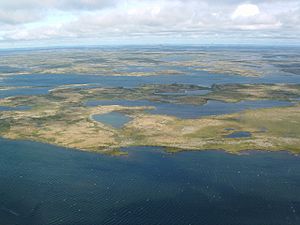Lake Nedlouc facts for kids
Quick facts for kids Lake Nedlouc |
|
|---|---|
 |
|
| Location | Rivière-Koksoak, Nunavik, Quebec |
| Coordinates | 57°23′30″N 72°45′47″W / 57.39167°N 72.76306°W |
| Type | Oligotrophic |
| Primary outflows | Charpentier River, Nedlouc River |
| Basin countries | Canada |
| Max. length | 18 km (11 mi) |
| Max. width | 25 km (16 mi) |
| Surface area | 44 km2 (17 sq mi) |
| Surface elevation | 329 m (1,079 ft) |
| Islands | Duck Island and many others |
Lake Nedlouc is a large and interesting lake located in the northern part of Quebec, Canada. It sits high up on a flat area called a plateau in the Ungava Peninsula. This lake is known for its clear, cool waters and the unique landscape around it.
Exploring Lake Nedlouc
Lake Nedlouc is quite big, stretching about 18 km (11 mi) long and 25 km (16 mi) wide. Its total area is around 44 km2 (17 sq mi). The lake is about 329 m (1,079 ft) above sea level.
What's in a Name?
The name "Nedlouc" comes from the Inuktitut language, which is spoken by the Inuit people. It means "part of the leg around the knee." It's a bit of a mystery why the lake was given this name!
The lake also has two other Inuktitut names. One is Nallualuk, but its meaning is not known. The other is Tasirtuuq, which means "many lakes." This name makes a lot of sense when you see the area.
Rivers and Geography
Lake Nedlouc is an important source for two rivers. The Charpentier River flows out from the north-west side, and the Nedlouc River flows from the north-east.
The lake itself is made up of two main parts. One part is in the south-east, and the other is in the north-west. These two larger sections are connected by smaller lakes and a series of shallow, fast-moving sections of the Charpentier River called rapids.
Nature Around the Lake
The area around Lake Nedlouc is a type of environment called arctic tundra. This means the land is very cold and often frozen, with very few trees. Any trees you might see are usually small and stunted because of the harsh conditions.
The lake is also described as "oligotrophic." This means its water is very clear and has low levels of nutrients. This type of lake often has deep, clean water and supports specific kinds of aquatic life. There are also several islands in the lake, including one called Duck Island.


